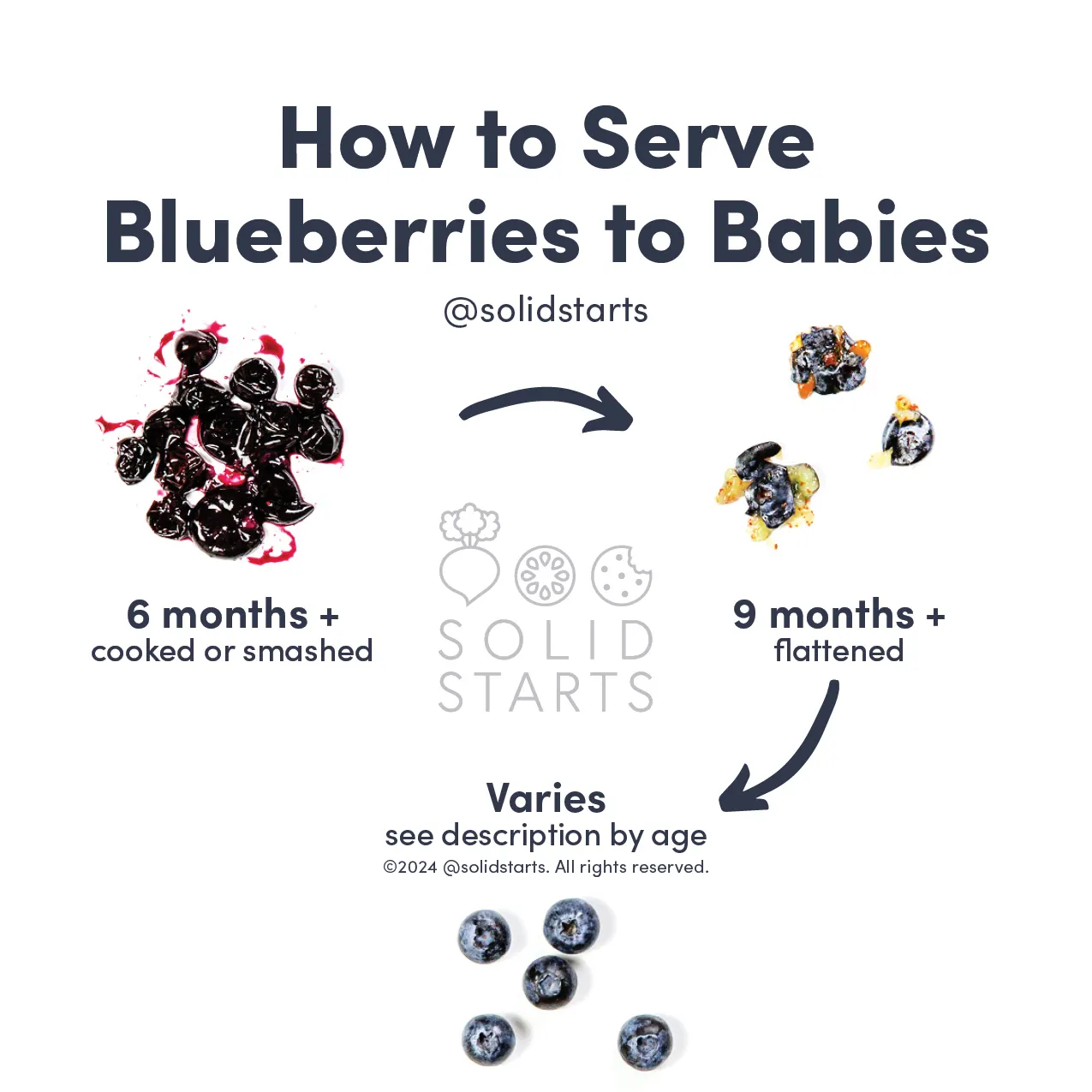Blueberries
Fruit
Age Suggestion
6 months
Iron-Rich
No
Common Allergen
No

Warning
The round shape of blueberries makes them a potential choking hazard. Read on to learn how to prepare them for babies and toddlers.
When can babies have blueberries?
Blueberries may be introduced as soon as baby is ready to start solids, which is generally around 6 months of age.
Blueberries grow around the globe, with Canada and the United States producing most of the world’s supply, though it wasn’t always this way. Blueberries descended from tundra plants that emerged across the Northern Hemisphere after the Ice Age. Many varieties of “blue” berries exist within this plant family, including bilberry (from Asia and Europe) and huckleberry (from North America) which are often colloquially called blueberries.
Are blueberries healthy for babies?
Yes. Blueberries are a good source of fiber and offer small amounts of plenty of other nutrients, such as vitamin E to protect cells from damage, vitamin K for healthy blood, and vitamin C, which helps our bodies absorb iron from plants – so try serving blueberries alongside iron-rich plant foods like lentils, beans, nuts, and seeds. Blueberries are also among the fruits highest in antioxidants, including anthocyanins, which protect our cells from damage and support heart health, blood sugar regulation, immunity, and gut health.
★Tip: Hold off on rinsing blueberries until you are ready to eat them. Blueberries stay freshest in the refrigerator without rinsing.
Are wild blueberries better than other kinds?
Not necessarily. Wild blueberries offer similar nutrients as the larger high-bush blueberries, although they tend to contain more antioxidants. Wild blueberries tend to be much smaller (about the size of a toddler’s thumbnail) which makes them a slightly higher choking risk and harder to modify. That said, if you have access to wild blueberries, enjoy! Just flatten them before serving to reduce the choking risk.
Are blueberries a common allergen?
No, blueberries are not a common allergen, although allergies to blueberries have been reported. Individuals who are sensitive to blueberry may also react to lingonberry and cranberry, which are closely related. Blueberry contains a lipid transfer protein (LTP) allergen that is known to cross-react with LTPs of a number of other foods, especially stone fruits such as peach, apricot, and cherry. This protein may also cross-react with raspberry, grape, chestnut, hazelnut, maize, barley, asparagus, carrot, and lettuce.
As you would when introducing any new food, start by offering a small amount during the first few servings. If there is no adverse reaction, gradually increase the amount served over future meals.
Are blueberries a choking hazard for babies?
Yes. Blueberries are small, round, and often firm, qualities that increase the risk of choking. To reduce the risk, prepare and serve blueberries in an age-appropriate way as described in the How to Serve section. As always, make sure you create a safe eating environment and stay within an arm’s reach of baby during meals.
Learn the signs of choking and gagging and more about choking first aid in our free guides, Infant Rescue and Toddler Rescue.
Videos
When can babies eat whole blueberries?
Once an older baby or toddler is taking bites and not stuffing their mouth with food, they can typically manage fresh whole blueberries in a safe eating environment. For most, this will be after the first birthday. That said, major healthy advisory bodies consider whole blueberries a common choking hazard until age four because of their round, firm shape. You may decide to work your way up to whole blueberries by flattening them a little less each time you serve them.
Can babies eat dried blueberries?
Yes, but only after the dried blueberries have been rehydrated in hot water until fully softened, to reduce choking risk. Hold off on serving unmodified dried blueberries until sometime after the second birthday, when the child has molars for chewing more challenging textures and is consistently chewing well and not stuffing their mouth, as dried fruit is challenging to chew and a potential choking hazard.
How do you serve blueberries to babies?
Every baby develops on their own timeline, and the suggestions on how to cut or prepare particular foods are generalizations for a broad audience.
6 months old +:
Cook ripe, fresh or frozen blueberries into warm cereals until the berries burst. Alternatively, smash whole berries that have been cooked until soft, then fold the smashed berries into soft, scoopable foods like grain porridge, ricotta cheese, or yogurt. You can also flatten uncooked blueberries into a disc to reduce the choking hazard, but know that babies at this age may struggle to pick up the small pieces of food, and putting food in a baby’s mouth significantly increases choking risk. Cooked blueberries (in muffins, pancakes, and other baked goods) can be left whole because they soften and burst with heat.
9 months old +:
Flatten large ripe blueberries to make little discs and serve directly on the tray or table, letting baby try to pick them up independently with their developing pincer grasp (where the thumb and forefinger meet). You can also continue serving blueberries in foods like yogurt, or bite-sized pieces of baked goods with blueberries in them.
12 months old +:
Continue to flatten ripe blueberries into discs, flattening a little less as your child’s eating skills mature and your comfort increases. At this age, many toddlers are also ready to eat a whole blueberry. Before you offer one, assess the child’s eating ability. If you see the child consistently chewing well and not stuffing their mouth, and you feel comfortable, you may offer a whole ripe blueberry in a safe eating environment. Make sure to offer one at a time, at first, model how to crush the berry with your teeth, and stay within arm’s each of the child. If the child is not quite ready for the whole berry, build up eating ability by flattening the berries a little less each time you serve.


Written by
Expert Tips Delivered to Your Inbox
Sign up for weekly tips, recipes and more!
The content offered on SolidStarts.com is for informational purposes only. Solidstarts is not engaged in rendering professional advice, whether medical or otherwise, to individual users or their children or families. No content on this site, regardless of date, should ever be used as a substitute for direct medical advice from your doctor or your medical or health professional, nutritionist, or expert in pediatric feeding and eating. By accessing the content on SolidStarts.com, you acknowledge and agree that you are accepting the responsibility for your child’s health and well-being. In return for providing you with an array of content “baby-led weaning” information, you waive any claims that you or your child may have as a result of utilizing the content on SolidStarts.com.










